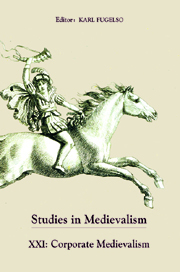Book contents
- Frontmatter
- Acknowledgments
- Contents
- Title in the Series
- Editorial Note
- I Corporate Medievalism: Some Perspective(s)
- Lives of Total Dedication? Medieval and Modern Corporate Identity
- Reincorporating the Medieval: Morality, Chivalry, and Honor in Post-Financial-Meltdown Corporate Revisionism
- Medievalism and Representations of Corporate Identity
- Knights of the Ownership Society: Economic Inequality and Medievalist Film
- A Corporate Neo-Beowulf: Ready or Not, Here We Come
- Unsettled Accounts: Corporate Culture and George R. R. Martin's Fetish Medievalism
- II Interpretations
- III Response
- Notes on Contributors
- Title in the Series
Lives of Total Dedication? Medieval and Modern Corporate Identity
from I - Corporate Medievalism: Some Perspective(s)
Published online by Cambridge University Press: 05 February 2013
- Frontmatter
- Acknowledgments
- Contents
- Title in the Series
- Editorial Note
- I Corporate Medievalism: Some Perspective(s)
- Lives of Total Dedication? Medieval and Modern Corporate Identity
- Reincorporating the Medieval: Morality, Chivalry, and Honor in Post-Financial-Meltdown Corporate Revisionism
- Medievalism and Representations of Corporate Identity
- Knights of the Ownership Society: Economic Inequality and Medievalist Film
- A Corporate Neo-Beowulf: Ready or Not, Here We Come
- Unsettled Accounts: Corporate Culture and George R. R. Martin's Fetish Medievalism
- II Interpretations
- III Response
- Notes on Contributors
- Title in the Series
Summary
In the Old English version of the Monasteriales Indicia, the sign for abbot is given as follows: Ærest þæs abbudes tacen is þæt mon his twegen fingras to his heafde asette, and his feax mid genime (“First, the sign for the abbot is that one puts one's two fingers to one's head, and takes hold of one's hair with them”). This might be more quickly explained as “lift two fingers to the head, and grip the hair.” In a Continental version this sign is clarified, so that it suggests not the tugging of the forelock, but that the hair that is gripped to indicate the abbot should be above the ear. The abbot was the head of the monastery, the leader of the corporate body of monks, and the spiritual and physical manager of the life of the monastery and its dependents. The dependents of a religious order could spread widely through a district, a country, and sometimes even beyond. Some abbots were powers indeed, and were among the significant figures in the land, traveling about with the king or high lord and witnessing charters as a matter of course. They had the kind of power over the monastics within their remit that a secular bishop could only hope for, though both fit elegantly into the pyramidal structure of the early Church.
- Type
- Chapter
- Information
- Studies in Medievalism XXICorporate Medievalism, pp. 1 - 10Publisher: Boydell & BrewerPrint publication year: 2012

